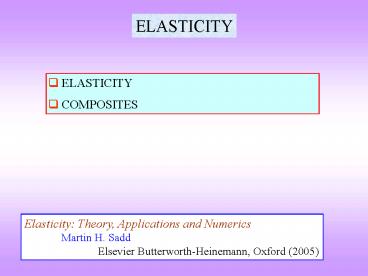ELASTICITY - PowerPoint PPT Presentation
1 / 16
Title:
ELASTICITY
Description:
Anisotropy in the Elastic modulus. In a crystal the interatomic distance varies with direction ... elastic anisotropy. Elastic anisotropy is especially ... – PowerPoint PPT presentation
Number of Views:104
Avg rating:3.0/5.0
Title: ELASTICITY
1
ELASTICITY
- ELASTICITY
- COMPOSITES
Elasticity Theory, Applications and
Numerics Martin H. Sadd Elsevier
Butterworth-Heinemann, Oxford (2005)
2
Recoverable
Instantaneous
Elastic
Time dependent
Anelasticity
Deformation
Instantaneous
Plastic
Time dependent
Permanent
Viscoelasticity
3
Elasticity
Linear
Elasticity
Non-linear
4
Atomic model for elasticity
Force
Energy
Attractive
Repulsive
A,B,m,n ? constantsm gt n
5
Repulsive
Repulsive
r0
Force (F) ?
Potential energy (U) ?
r ?
r ?
r0
Attractive
Attractive
r0
Equilibrium separation
6
Near r0 the red line (tangent to the F-r curve at
r r0) coincides with the blue line (F-r) curve
r ?
Force ?
r0
For displacements around r0 ? Force
displacement curve is approximately linear? THE
LINEAR ELASTIC REGION
7
Youngs modulus (Y / E)
- Youngs modulus is to the ve slope of the
F-r curve at r r0
Stress ?
Tension
strain ?
Compression
Youngs modulus is not an elastic modulus but
an elastic constant
8
Stress-strain curve for an elastomer
Tension
?T due to uncoilingof polymer chains
Stress ?
?C
strain ?
?T
Due to efficient filling of space
Compression
?C
?T
gt
9
Other elastic modulii
- ? E.? E ? Youngs modulus
- ? G.? G ? Shear modulus
- ?hydrodynami K.volumetric strain K ? Bulk
modulus
10
Bonding and Elastic modulus
- Materials with strong bonds have a deep
potential energy well with a high curvature ?
high elastic modulus - Along the period of a periodic table the
covalent character of the bond and its strength
increase ? systematic increase in elastic modulus - Down a period the covalent character of the
bonding ? ? ? in Y - On heating the elastic modulus decrease 0 K ?
M.P, 10-20 ? in modulus
11
Anisotropy in the Elastic modulus
- In a crystal the interatomic distance varies
with direction ? elastic anisotropy - Elastic anisotropy is especially pronounced in
materials with ? two kinds of bonds E.g. in
graphite E 10?10 950 GPa, E 0001 8 GPa
? Two kinds of ordering along two
directions E.g. Decagonal QC E 100000 ?? E
000001
12
Material dependence
Elastic modulus
Property
Geometry dependence
Elastic modulus in design
- Stiffness of a material is its ability to resist
elastic deformation of deflection on loading ?
depends on the geometry of the component. - High modulus in conjunction with good ductility
should be chosen (good ductility avoids
catastrophic failure in case of accidental
overloading) - Covalently bonded materials- e.g. diamond have
high E (1140 GPa) BUT brittle - Ionic solids are also very brittle
13
- METALS
- ? First transition series ? good combination
of ductility modulus (200 GPa) ? Second
third transition series ? even higher modulus,
but higher density - POLYMERS ? Polymers can have good plasticity
? but low modulus dependent on - ? the nature of secondary bonds- Van der Walls /
hydrogen ? presence of bulky side groups ?
branching in the chains ? Unbranched
polyethylene E 0.2 GPa, ? Polystyrene
with large phenyl side group E 3 GPa, ?
3D network polymer phenol formaldehyde E 3-5
GPa ? cross-linking
14
Increasing the modulus of a material
- METALS
- ? By suitably alloying the Youngs modulus can be
increased - ? But E is a structure (microstructure)
insensitive property ? the increase is ?
fraction added? TiB2 ( spherical, in
equilibrium with matrix) added to Fe to increase
E - COMPOSITES? A second phase (reinforcement) can
be added to a low E material to ? E (particles,
fibres, laminates)? The second phase can be
brittle and the ductility is provided by the
matrix ? if reinforcement fractures the crack is
stopped by the matrix
15
COMPOSITES
Laminate composite
Alignedfiber composite
Particulate composite
Modulus parallel to the direction of the fiberes
- Under iso-strain conditions
- I.e. parallel configuration
- m-matrix, f-fibre, c-composite
Volume fractions
16
Composite modulus in isostress and isostrain
conditions
- Under iso-strain conditions ?m ?f ?c
- I.e. resistances in series configuration
- Under iso-stress conditions ?m ?f ?c
- I.e. resistances in parallel configuration
- Usually not found in practice
Ef
Isostrain
Ec ?
Isostress
For a given fiber fraction f, the modulii of
various conceivable composites lie between an
upperbound given by isostrain conditionand a
lower bound given byisostress condition
Em
f
A
B
Volume fraction ?































